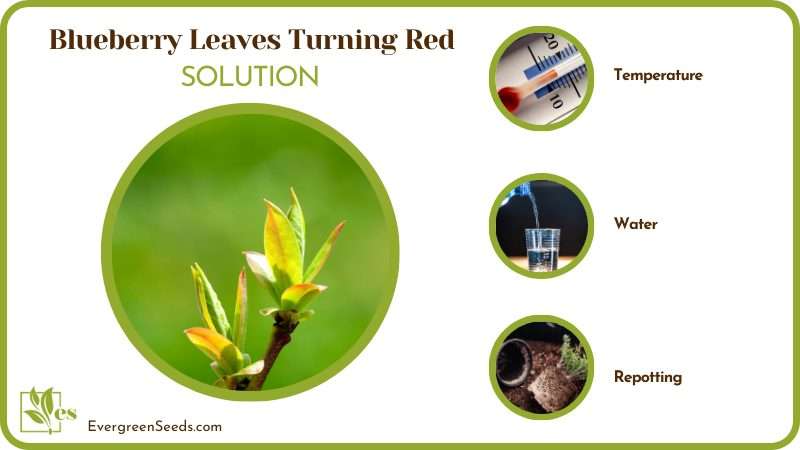Blueberry leaves turning red can be very beautiful during autumn, but red blueberry leaves in summer and spring are not normal. If the leaves are red when they should be green, you should check your plants and make sure that you are properly caring for them.

Why do blueberry leaves turn red and what should you do about it? Continue reading this comprehensive guide to discover the answers to these questions and more.
JUMP TO TOPIC
Why Are My Blueberry Leaves Turning Red?
The leaves of your blueberry plants can turn red because of nutrient deficiency and cold temperatures, among other reasons. Some common reasons your blueberry leaves are turning red include:
– Nutrient Deficiency
Blueberry leaves turning red during spring or summer usually indicate that your plants are lacking in phosphorus, magnesium and other nutrients. These micronutrients are important for blueberries to produce their fresh green pigmentation.
If your blueberries lost their bloom without fruiting in the previous growing season and their leaves are turning red in the current growing season, it indicates nutrient deficiency. You should grow your blueberries in nutrient-rich soil or potting mix. Also, do not forget to fertilize your plants occasionally.
– Exposure to Cold
Blueberry plants can produce red leaves during winter. This is because temperature plays a role in the type of pigments produced in blueberry leaves. If you plant your blueberries early in spring before the soil warms up or you are growing heat-loving varieties in a cold region, your plant leaves can become red. Note that most blueberry varieties grow best within the USDA hardiness zones of 3-8.
– Disease
Your blueberry plants might be under attack by fungi or bacteria. While the symptoms of different diseases vary, diseases such as phomopsis twig blight, blueberry leaf scorch and red ringspots can cause red coloration in the leaves. For example, you will notice red spots on blueberry leaves if they have red ringspots.
Red leaves in your blueberries can indicate various diseases, so you should take a twig or leaf to a local extension office for proper diagnosis. You can also contact expert farmers around you. If you find red leaves in one of your blueberries, you should start isolating that plant immediately.
Use the recommended treatment products to cure your blueberries. In addition, you should repot your potted blueberries into a new pot and potting mix and properly sterilize the current potting mix.

– Soil pH
Blueberry plants prefer acidic soil with pH levels ranging from 4.5 to 5.0. If the soil is more acidic or basic than the requirement of your plants, they will indicate their unhappiness by producing some off-colored leaves. Soil with unsuitable pH can affect the way your blueberry plants absorb nutrients or water and cause red leaves on blueberry bush.
You should check your soil pH with a pH meter. If the soil is not within the correct range of your blueberry requirements, you should amend it. Some products to help amend your soil pH are:
- Coffee grounds
- Pine bark mulch
- Alfalfa meal
- Composted manure
- Peat moss
- Dried leaves
Make sure that you pay close attention to the pH of your blueberry soil as pH is a very important soil factor.
– Compacted Soil
Compacted soil does not just make your blueberry leaves turn red, it can also kill your plants. Compacted soil does not allow oxygen to reach the roots of your blueberries and can suffocate the plants.
Your blueberry soil should be well-drained and full of grit for proper aeration and water drainage. For potted blueberries, you should buy suitable potting mix or garden soil from gardening shops. If your garden soil is compacted, remove the blueberry plants, amend the soil, and then replant the blueberries. You should also check for and remove dead roots from your plants.
– Transplant Shock
Remember that temperature is a very important factor that affects the pigmentation of your blueberry leaves. If you transplant your blueberry plants too early in spring or too late towards winter, your plants can get shocked by the immediate change in temperature. The temperature indoors is very different from the outside temperature.
To transplant your blueberries in early spring, wait until the soil has warmed up. Remember to take your heat-loving potted blueberry plants indoors during late fall.
– Autumn
Even though your blueberries should not produce red leaves during spring or summer, remember that blueberry leaves (just like the leaves of several other plants) can turn red in autumn. Blueberry bush leaves turning red in autumn should not bother you. Instead, it is the perfect time to enjoy this beautiful display.
Considering that your blueberry leaves can turn red mostly because of stress or lack of care, you should remember to always care for your plants.
Essential Care Tips for Blueberries
Here are some recommended blueberry care tips for you, to ensure that you are giving them the best possible life.
– Preparing the Soil or Potting Mix
Your blueberry soil or potting mix should have at least 20 percent organic matter. You can mulch your blueberries with organic mulch as organic mulch can act as a slow-release fertilizer for the plants. If you are mixing the potting mix by yourself, you should make sure that it is well-drained.
Pay close attention to the pH of your blueberry soil. Also, if you are using soil from your yard in pots, you should sterilize it first by baking the soil.
– Light and Humidity
Blueberries need full sunlight. You should plant your blueberries in a location where they can get at least six hours of direct sunlight every day. Your blueberries can lose their green pigmentation if not given enough light, and your plants might lose their bloom or fruits in insufficient light.
As for humidity, blueberries do not have any special humidity needs. You can grow them in average humidity as they are adaptable. To increase the humidity around your blueberries, you can use a humidifier or mist water around the plants.
– Temperature
Blueberries grow best in USDA hardiness zones 3-8. The ideal temperature for blueberries is 45 degrees Fahrenheit, but they can tolerate temperatures ranging from 35-55 degrees Fahrenheit. If you are growing a heat-loving variety, remember to take your plants indoors during winter so that they will not die.
– Water
You need to pay close attention to your blueberry watering technique. Blueberries lack hairs in their roots, so they cannot tolerate fluctuating soil moisture. They prefer consistently moist soil, just make sure that it is not soggy.
You should water your blueberries daily in the morning, but make sure that the soil is not completely dry before watering the plants. You can water the plants by misting the leaves as well, as this keeps them fresh.
Do not water your blueberries with cold water as this can make them produce red leaves during spring or summer. Always let your tap water sit out for at least six hours before watering your blueberries with it.
– Nutrient
In a proper soil or potting mix, you do not need to fertilize your blueberries in the first year of planting as its media is still nutrient-rich. Your plants will indicate that they need to be fertilized when they begin to have stunted growth. You should not wait for your blueberries to indicate that they need nutrients before you give them what they need.
You can fertilize your blueberries with any blueberry fertilizer or a product with an NPK ratio of 10-10-10. You can easily get blueberry fertilizer from a gardening shop near you.

– Pruning
You do not need to prune your blueberries in the first 2-3 years after planting. In their first year or two, you should remove flower and fruit buds to encourage bushy growth. When it is time to prune your plants, prune them in late winter or early spring when they are dormant.
You can use gardening scissors to prune your blueberries, just make sure that the scissors are sterilized. In addition, prune at least 6 inches of twigs off your blueberries. You can plant these twigs afterward for more plants.
– Repotting
Blueberries do not usually need to be repotted, but you have to repot the plant for a few reasons:
- Disease: If any of your potted blueberry plants have been diseased, you have to sterilize the pot or potting mix first before using them again. Before planting the revived plant in a new pot, make sure that you remove its dead roots and leaves.
- Soil: If the soil or potting mix has become compacted, does not drain water quickly, or is suffocating the roots of your blueberries, you should repot the plant into a new pot and potting mix.
- Size: Size matters. If your blueberry plants are growing larger than their pot or their roots no longer have space in the potting mix, you should repot them into a larger pot.
You can use a new pot just a few inches larger than the previous pot when repotting your blueberries.
– Weed Control
Weeds can compete with your blueberries for sunlight and nutrients. You should remove weeds immediately after you see them. Remember to mulch your blueberries early so that weeds cannot grow from the soil, and do not allow weeds to stay for a long time as they can cause nutrient deficiencies in your blueberries.
Other Blueberry-Related Problems to Watch Out For
Aside from the leaves of your blueberries turning red, there are other problems that your blueberries can face. Here are some common issues faced by blueberry plants and what you can do about them:
– Pests
Insect pests usually attack blueberries. You can easily repel insect pests using pesticides and other products. When your blueberries produce fruits, they can also be eaten by birds, which you can prevent by nesting your blueberries.
You can grow your blueberries in a controlled environment such as a greenhouse to prevent pests from reaching them.
– Chlorosis
Chlorosis occurs when the leaves of your blueberries turn yellow. Chlorosis can be caused by various reasons. Some reasons your blueberries can lose their green pigmentation are:
- Light: Lack of sufficient light is the most common reason your blueberries can become yellow or lose their fresh green color. Other symptoms of light deficiency include stunted growth and weak stems.
- Water: When your blueberries are drowning in water, their leaves can become yellow. Make sure that the soil is moist and not damp or soggy.
- Disease: Various bacteria and fungi diseases can cause chlorosis. If chlorosis occurs in just a section of a blueberry plant, remove the affected twig for diagnosis.
Make sure that you pay attention to the color of your blueberry leaves as you can use it to detect problems in your plants.
– Root Rot
Root rot is caused by overwatering your blueberries. When the roots do not receive enough oxygen because of soggy soil, they will start to decay and will be attacked by many fungi species. Amend the soil by baking it and making sure that it is well-drained. Remove dead roots from your sick plants as well.
Make sure that the soil is consistently moist, not damp or soggy.












